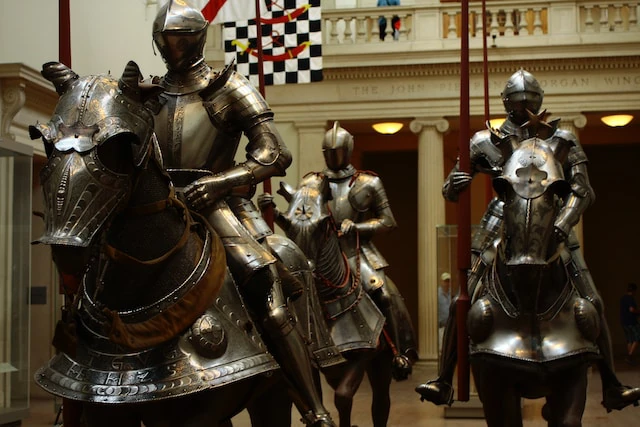Demystifing Defense: How Does AC Work in 5e

Greetings, fellow adventurers! Today, we’re diving into the magical world of Armor Class (AC) in Dungeons & Dragons 5th Edition. If you’ve ever wondered about the intricacies of defending against a dragon’s fiery breath or a rogue’s sneak attack, you’re in the right place. Let’s unravel the mystery together and learn how AC works in the world of D&D.
What is Armor Class (AC)?
In Dungeons & Dragons (D&D), Armor Class (AC) is a numerical representation of how difficult it is to land a successful attack on a character or monster. It serves as a measure of a character’s ability to avoid being hit, whether through physical agility, protective gear, or magical enhancements.
How is Armor Class (AC) Calculated in 5e?
AC is calulated using a simple formula:
AC = Base AC + Dexterity Modifier (if applicable) + Armor Bonus + Shield Bonus + Other Modifiers (if any)
The tricky part is knowing which values to use, but don’t worry I’ve got you covered.
Your Base AC is modified based on the type of armor you are wearing and typically ranges from 10 - 14
No Armor
When wearing no armor your base AC is 10. You add you dexterity modifer, which represents your character’s ability to dodge an attack.
That’s it! and you have your AC.
Don’t always asumme that more armor is better! There are some character classes that thrive when not wearing armor.
The Monk is a prime example of a class that benefits from forgoing armor, their Unarmored Defense feature allows them to calculate their Armor Class using their Wisdom and Dexterity modifiers. Monks employ a disciplined and agile fighting style that embraces free movement and swift strikes, making armor unnecessary for their defensive prowess.
The Barbarian class revels in their primal strength and endurance, often opting for their own Unarmored Defense as they rage into battle. Unlike the Monk’s version of Unarmored Defense the Barbarian can use a shield.
Both classes showcase the versatility of characters who, through training or inherent abilities, find their greatest strength lies in not being bound by conventional armor, moving with unparalleled agility on the battlefield.
Light Armor

Light armor is designed for characters who prioritize agility and swift movements over heavy defense. Typically crafted from materials like leather or padded fabric, light armor allows wearers to maintain their agility and flexibility, crucial for classes that rely on finesse and evasion. Rogues and Rangers often favor light armor for its minimal encumbrance, enabling them to move stealthily and dodge attacks with ease.
Light armor sets a base Armor Class, and wearers can add their Dexterity modifier (up to a certain limit) to enhance their defense. The appearance of light armor is often sleek and unobtrusive, providing a balance between protection and the freedom of movement. Characters adorned in light armor embody a blend of nimbleness and practicality, making them adept at slipping through shadows or swiftly navigating the complexities of the battlefield.
Wearing one of the standard non-magic light armors in fifth edition changes your Base AC by up to two points, depending on which armor you are wearing
| Armor | Base AC | Cost | Weight | Stealth |
|---|---|---|---|---|
| Padded Armor | 11 | 5 gp | 8lbs | Disadvantaged |
| Leather Armor | 11 | 10 gp | 10 lbs | |
| Studded Leather Armor | 12 | 45 gp |
Medium Armor

Medium armor is a versatile category of protective gear that offers a balance between flexibility and defense. Generally made from materials like metal or scale, medium armor provides a moderate level of protection without sacrificing the wearer’s mobility entirely. Characters proficient in medium armor, such as Fighters and Rangers, benefit from its durability and the added protection it affords on the battlefield.
Unlike heavy armor, medium armor allows for more agility, permitting wearers to utilize their Dexterity modifier (up to a certain limit) to enhance their Armor Class. The distinctive appearance of medium armor often consists of interlocking metal pieces or scales, creating a formidable and practical ensemble for those who seek a middle ground between the nimbleness of light armor and the robust defense of heavy armor.
| Armor | Base AC | Cost | Weight | Stealth |
|---|---|---|---|---|
| Hide Armor | 12 | 10 gp | 20 lbs | |
| Chain Shirt | 13 | 50 gp | 20 lbs | |
| Scale Mail | 14 | 50 gp | 45 lbs | Disadvantged |
| Breast Plate | 14 | 400 gp | 20 lbs | |
| Half Plate | 15 | 750 gp | 40 lbs | Disadvantged |
Heavy Armor

Heavy armor in Dungeons & Dragons is the epitome of battlefield resilience, providing exceptional protection to those who don it. Crafted from robust materials such as metal plates and chain links, heavy armor is the go-to choice for characters seeking to absorb the brunt of attacks. Classes like Paladins and Fighters are often proficient in heavy armor, embracing its ability to turn aside blows with unwavering strength.
Unlike lighter armors, heavy armor usually sets a fixed base Armor Class, not allowing for the addition of a character’s Dexterity modifier. This lack of reliance on agility is compensated by the sheer durability and sturdiness of the armor, creating a formidable appearance on the battlefield. The imposing nature of heavy armor conveys an image of a warrior unyielding in the face of danger, an impervious bulwark that embodies both protection and an imposing presence on the front lines of adventure.
| Armor | Base AC | Cost | Weight | Stealth |
|---|---|---|---|---|
| Ring Mail | 14 | 30 gp | 40 lbs | Disadvantged |
| Chain Mail | 16 | 75 gp | 55 lbs | Disadvantged |
| Splint | 17 | 200 gp | 60 lbs | Disadvantged |
| Plate | 18 | 1500 gp | 65 lbs | Disadvantged |
Aromor Proficency
It’s important to note that a character’s proficiency with certain types of armor can impact their effective use. Additionally, characters might have special abilities or features that modify their AC, and magical enhancements can further increase AC through enchanted armor or shields.
Here are the Armor Proficiencies for each character class:
| Class | Armor Proficiency |
|---|---|
| Artificer | Light, Medium |
| Barbarian | Light, Medium |
| Bard | Light |
| Cleric | Light, Medium |
| Druid | Light, Medium (Non-metal) |
| Fighter | All |
| Monk | None |
| Paladin | All |
| Ranger | Light, Medium |
| Rogue | Light |
| Sorcerer | None |
| Warlock | Light |
| Wizard | None |
If you wear an armor that you are not proficent with you will suffer the following penalties:
- You will be unable to cast spells
- You gain disadvantage on:
- Any ability check involving Strength or Dexterity
- Any saving throw involving Strength or Dexterity
- Any attack roll involving Strength or Dexterity
Other Way to Boost AC

AC does not automatically increase with character level. While characters gain new abilities and options as they level up, the base calculation for AC remains consistent, but there are other ways you can increase your AC.
Class Features
Class features not only reflect the thematic essence of a character but also provide tailored enhancements to their AC, creating diverse and dynamic defensive capabilities that extend beyond mundane armor. We’ve already discussed how both the Monk and Barbarian classes that make it adventagous for them to not wear armor at all. Certain Cleric domains, like the Forge Domain (found in Xanathar’s Guide to Everything), offer class features that empower characters to enchant their armor, providing additional magical protection. Wizards rely on magic to boost their AC since wearing armor keeps them from casting spells!
Magic Items
You don’t have to be a wizard to boost your AC with magic, the acquisition and use of magical items can add an extra layer of protection beyond conventional armor. Enchanted armor, such as +1 or +2 variants, directly increases AC by the indicated bonus. Shields with magical enhancements can provide additional AC as well, offering a formidable defense against incoming attacks.
Rings, amulets, or cloaks with protective enchantments contribute to a character’s overall magical defense, often providing unique bonuses or resistances. The strategic integration of these magical items into a character’s equipment not only enhances survivability but also adds an element of personalization to their overall playstyle, making each adventurer a unique and formidable force on the battlefield.
Racial Traits
The race you choose when creating a character can offer a distinct advantage that contributes to their overall defense. For example, Mountian Dwarves, with their Dwarven Armor Training trait, gain proficiency in wearing medium armor, which can significantly boost their AC. Dexterity bonuses or natural armor granted by certain races, such as the Lizardfolk or the Tortle, can directly influence AC.
Some races, like the Warforged, have integrated protection, providing a flat bonus to AC due to their inherent construct nature. These racial traits not only reflect the unique characteristics of each race but also offer players the opportunity to tailor their character’s defensive capabilities to match their chosen race’s strengths, creating a diverse and dynamic array of characters with varying levels of protection on their adventuring journeys.
Feats
Feats in Dungeons & Dragons can significantly influence a character’s Armor Class (AC) by providing unique abilities and bonuses that enhance defensive capabilities. Certain feats are specifically designed to bolster protection, such as the “Defensive Duelist” feat, which allows characters to use their proficiency bonus to boost AC against a single melee attack when wielding a finesse weapon. The “Heavy Armor Master” feat, on the other hand, reduces incoming damage from non-magical attacks while wearing heavy armor. The selection of feats can be a strategic decision, allowing players to customize their characters and tailor their defensive strengths to suit their preferred playstyle, adding depth and versatility to the overall character build.
Spells
Spells can influence a character’s Armor Class (AC) in various ways, providing magical enhancements and defensive buffs. Here are a few ways spells can impact AC:
Mage Armor: A spell like Mage Armor provides a magical protective barrier, setting the target’s base AC at 13 + Dexterity modifier. This is particularly beneficial for characters who may not wear armor.
Shield: The Shield spell can be cast as a reaction in response to being attacked, granting a +5 bonus to AC until the start of the caster’s next turn. This can be a lifesaver in critical moments, helping characters avoid hits.
Barkskin: Barkskin sets the target’s AC to a minimum of 16, regardless of Dexterity modifiers or armor worn. It’s often used to enhance the AC of characters with low Dexterity or those who don’t wear traditional armor.
Haste: The Haste spell not only increases a target’s speed but also provides a +2 bonus to AC, making the recipient more difficult to hit.
Shield of Faith: This spell increases the AC of a creature by +2 for the duration, providing a valuable boost to defensive capabilities.
It’s important to note that the availability of these spells depends on the character’s class and spellcasting ability. Spellcasters, such as Wizards, Sorcerers, and Clerics, have access to a wide range of spells that can be used strategically to enhance their AC or the AC of their allies.
Cover
Another way to make yourself harder to hit is to put something between yourself and your attacker! The amount cover impacts your AC depends on the degree of cover:
Half Cover: When a character is behind an obstacle that blocks at least half of their body, they gain a +2 bonus to AC. This could be a low wall, a large piece of furniture, or a similar obstruction.
Three-Quarters Cover: When a character is behind a substantial barrier that provides significant protection, such as a large tree or a pillar, they gain a +5 bonus to AC.
Full Cover: A character is considered to have total cover when they are completely concealed and protected, such as being inside a fully enclosed room or behind a solid wall. In such cases, the character cannot be directly targeted by attacks.
For more information about how cover works, check out our post on the topic!
Shields
Any character can carry a shield if they have a free hand for a +2 bonus to AC!
Frequently Asked Questions
What happens on a tie?
This is really up to your DM, I’ve seen it done both ways, but the rules as written state that if an attack meets target AC the hit is sucessful.
How does Wild Shape affect my AC?
Whne you’re playing a Druid and shapeshift into an creature your AC becomes the AC of that creature. When that AC is reduced to zero, you become yourself again and have whatever hitpoints you had before you cast Wild Shape.
Can my AC go over 20?
Yes it can.
Does AC increase with level?
AC does not automatically increase with character level. While characters gain new abilities and options as they level up, the base calculation for AC remains the same.


